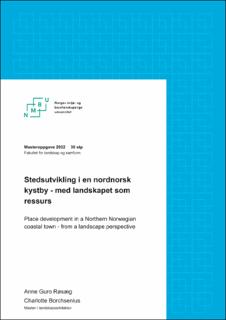| dc.contributor.advisor | Clemetsen, Morten | |
| dc.contributor.author | Røsæg, Anne Guro | |
| dc.contributor.author | Borchsenius, Charlotte | |
| dc.coverage.spatial | Norway, Nordland, Helgeland, Sandnessjøen | en_US |
| dc.date.accessioned | 2022-09-23T09:32:36Z | |
| dc.date.available | 2022-09-23T09:32:36Z | |
| dc.date.issued | 2022 | |
| dc.identifier.uri | https://hdl.handle.net/11250/3020880 | |
| dc.description.abstract | Mange byer og tettsteder bærer i dag preg av å ha mistet sitt særpreg som følge av mangel på stedsutvikling som er lokalt forankret. Samtidig preges mange tettsteder og småbyer i Distrikts-Norge av sentralisering og fraflytting. Dette er også tilfellet for kystbyen Sandnessjøen på Ytre Helgeland. Denne avhandlingen ser på hvordan byens attraktivitet kan styrkes gjennom stedstilpasset sentrumsutvikling i Sandnessjøen.
I denne oppgaven handler en stedstilpasset utvikling om utvikling tilpasset de ytre karaktertrekkene, men også de indre kvalitetene ved landskapet. Det indre landskapet beskriver relasjonen mennesker har til stedet. For å finne disse kvalitetene i landskapet er landskapsressursanalysen (LRA) brukt som metodisk verktøy. Oppgavens LRA søker å finne en balanse mellom å bevare viktige verdier og å se potensiale for videre utvikling i Sandnessjøen. Funnene fra LRA munner ut i en mulighetsstudie som aktiviserer de unike natur- og kulturressursene og bidrar til en utvikling som er lokalt forankret til byen.
LRA har kartlagt sammenhengen mellom Sandnessjøens rike ressursgrunnlag og byens bruk og aktivitet. Nærhet til havet, fjellandskapet, landskapets kulturhistorie og befolkningens relasjonelle kvaliteter til hverandre og stedet, påvirker stedets særpreg. Likevel har en endret bruk av landskapet ført til at byens kvaliteter er endret. Tidligere var sentrum, spesielt havneområdet, en viktig arbeids- og møteplass for primærnæringer. I dag blir imidlertid store deler av havneområdene brukt som parkeringsplass for biler. I likhet med havna, har flere av byens uformelle møteplasser blitt svekket. Dette har både sammenheng med at byen har distansert seg fra naturen og havet og at byen har mistet mye av sin kystbyidentitet.
I mulighetsstudien presenteres grep med påfølgende strategier og tiltak for hvordan natur- og kulturgrunnlaget kan styrke leve- og opplevelsesverdiene i Sandnessjøen. Grepene illustrerer hvordan byens ressursgrunnlag kan aktiviseres på en måte som styrker menneskers tilknytning til det naturgitte, kulturelle, relasjonelle og historiske. Avhandlingen konkluderer med at befolkningens tilknytning til stedet kan være avgjørende for Sandnessjøen som et attraktivt leve- og opplevelsessted. | en_US |
| dc.description.abstract | Today, many of Norway’s towns and cities have lost their individual character and identity due to a lack of locally centered development. In addition, many towns and smaller cities in the rural districts of Norway have been affected by both centralization and loss of population due to relocation. This is the case in the coastal city of Sandnessjøen in Ytre Helgeland. This thesis examines how a city’s attractiveness could be strengthened through adapted place development.
This thesis explores adapted place development of the landscape’s outer and inner qualities. The inner landscape is described as the people’s relation to the landscape. To identify these qualities, a landscape resource analysis (LRA) was utilized as the methodic tool. In this thesis, the LRA aims to find a balance between the preservation of important values and the identification of them in further development in Sandnessjøen. The LRA leads into a feasibility study that aims to activate unique natural and cultural resources that can contribute to a place adapted development of Sandnessjøen.
The LRA has mapped the connection between Sandnessjøen’s rich resource base and the city’s use and activity. Strategically located on the coast, the town is a regional center in Ytre Helgeland. It’s closeness to the sea, mountain landscape, the cultural history of the landscape and the population’s regard for each other and the place, make it distinctive. Nevertheless, changes in the use of the landscape have led to a change in the city’s qualities. Previously, the city center, especially near the harbor, was an important work and meeting place for primary industries. Today, however, large parts of the harbor are used as parking spaces for cars. The harbor serves less as an informal meeting place for spontaneous gatherings. This is due to the city distancing itself from nature and the sea and losing much of its coastal identity and spontaneous meeting places.
The feasibility study presents measures with subsequent strategies, and solutions for how the natural and cultural resources can strengthen quality of life and experiences in Sandnessjøen. The measures illustrate how the city’s resources could be activated in a way that strengthens people’s connection to natural, cultural, relational and historical elements. The thesis concludes that the population’s connection to the place can be Adecisive for Sandnessjøen to stay an attractive place to live and visit. | en_US |
| dc.language.iso | nob | en_US |
| dc.publisher | Norwegian University of Life Sciences, Ås | en_US |
| dc.rights | Attribution-NonCommercial-NoDerivatives 4.0 Internasjonal | * |
| dc.rights.uri | http://creativecommons.org/licenses/by-nc-nd/4.0/deed.no | * |
| dc.subject | Stedsutvikling | en_US |
| dc.subject | Place development | en_US |
| dc.title | Stedsutvikling i en nordnorsk kystby : med landskapet som ressurs | en_US |
| dc.title.alternative | Place development in a Northern Norwegian coastal town : from a landscape perspective | en_US |
| dc.type | Master thesis | en_US |
| dc.description.localcode | M-LA | en_US |

